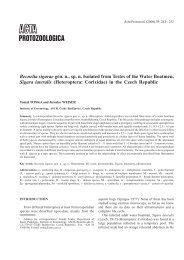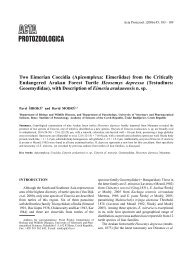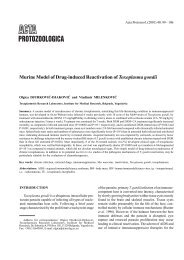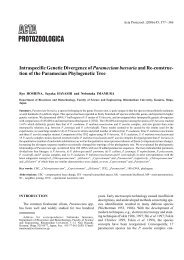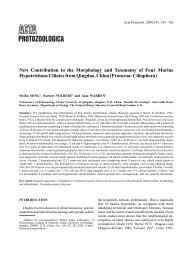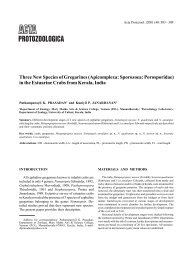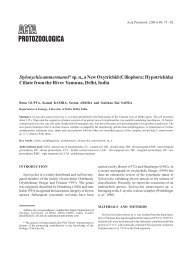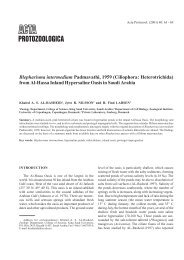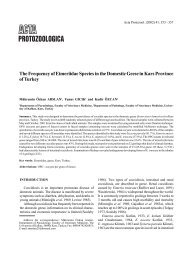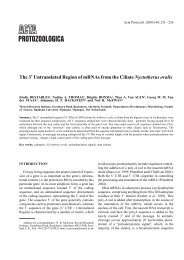Light Regulation of Protein Phosphorylation in Blepharisma japonicum
Light Regulation of Protein Phosphorylation in Blepharisma japonicum
Light Regulation of Protein Phosphorylation in Blepharisma japonicum
Create successful ePaper yourself
Turn your PDF publications into a flip-book with our unique Google optimized e-Paper software.
314 H. Fabczak et al.<br />
Figs 3 A, B. Detection <strong>of</strong> light-<strong>in</strong>duced prote<strong>in</strong> phosphorylation <strong>in</strong><br />
<strong>Blepharisma</strong> by monoclonal antibody, Pser-1C8. A - 20 m<strong>in</strong>. exposure<br />
<strong>of</strong> immunoblot to X-ray film. B - quantification <strong>of</strong> ser<strong>in</strong>e phosphorylation<br />
<strong>of</strong> the 28 kDa prote<strong>in</strong>. Other details as <strong>in</strong> Fig. 1<br />
depolarization, the effect <strong>of</strong> ionic stimulation was exam<strong>in</strong>ed.<br />
These experiments <strong>in</strong>dicate that the phosphorylation<br />
level <strong>of</strong> prote<strong>in</strong>s <strong>of</strong> 28 kDa and 46 kDa was<br />
unaffected by membrane depolarization compared to<br />
cell samples exposed to light (Figs 1 A, B; 2 A; 3 A and<br />
lane 5). The pattern <strong>of</strong> prote<strong>in</strong> phosphorylation <strong>in</strong> cell<br />
samples, which were first treated with K + and subsequently<br />
exposed to light (Figs 1 A, B; 2 A; 3 A and<br />
lane 6), was similar to that obta<strong>in</strong>ed for cells that were<br />
only illum<strong>in</strong>ated (Figs 1 A; 2 A; 3 A and lane 2).<br />
The results <strong>of</strong> semi-quantitative analysis <strong>of</strong> prote<strong>in</strong><br />
phosphorylation <strong>in</strong>dicated that the level <strong>of</strong> phosphorylation<br />
<strong>of</strong> 46 kDa prote<strong>in</strong>s by 2 s illum<strong>in</strong>ation caused a tw<strong>of</strong>old<br />
<strong>in</strong>crease over the values found <strong>in</strong> dark-adapted cells<br />
(Figs 1 C; 2 B). In the case <strong>of</strong> the 28 kDa polypeptide,<br />
the level <strong>of</strong> phosphorylation is lower <strong>in</strong> all cell samples<br />
exposed to light. The phosphorylation levels for both<br />
these prote<strong>in</strong>s returned to the control levels after about<br />
300 s <strong>of</strong> cell <strong>in</strong>cubation under dark conditions (Figs 1 C,<br />
2 B, 3 B).<br />
It has been shown that phosphorylation and dephosphorylation<br />
<strong>of</strong> cellular prote<strong>in</strong>s play a crucial role <strong>in</strong> the<br />
regulation <strong>of</strong> various sensory transduction pathways<br />
(Greengard 1978, Cohen 1982, Bünemann and Hosey<br />
1999, Dickman and Yarden 1999, Graves and Krebs<br />
1999). In the visual system, light <strong>in</strong>duces phosphorylation<br />
<strong>of</strong> photoreceptors (rhodops<strong>in</strong>) by a prote<strong>in</strong> k<strong>in</strong>ase<br />
(Bownds et al. 1972, Kühn 1974, Frank et al. 1973). The<br />
higher light <strong>in</strong>tensity causes a marked dephosphorylation<br />
<strong>of</strong> prote<strong>in</strong>s <strong>of</strong> low molecular weight <strong>in</strong> <strong>in</strong>tact rods (Polans<br />
et al. 1979, Lee et al. 1984, Bownds and Brewer 1986).<br />
In the present study, we showed that light is capable <strong>of</strong><br />
<strong>in</strong>fluenc<strong>in</strong>g the level <strong>of</strong> prote<strong>in</strong> phosphorylation <strong>in</strong><br />
<strong>Blepharisma</strong> <strong>japonicum</strong>, as it takes place <strong>in</strong> the photoreceptor<br />
cells <strong>of</strong> vertebrates. In this ciliate, however, the<br />
prote<strong>in</strong>s be<strong>in</strong>g phosphorylated or dephosphorylated by<br />
light have not yet been identified. It was recently shown<br />
that the photosensory pigment blepharism<strong>in</strong> <strong>in</strong><br />
<strong>Blepharisma</strong> <strong>japonicum</strong> is associated with a 200 kDa<br />
membrane prote<strong>in</strong> (Matsuoka et al. 2000). It is likely<br />
that the polypeptide <strong>of</strong> molecular weight <strong>of</strong> 46 kDa,<br />
which underwent highly specific phosphorylation on<br />
ser<strong>in</strong>e after light stimulation, is associated with the<br />
200 kDa complex photoreceptor prote<strong>in</strong> or it simply<br />
represents a fragment <strong>of</strong> the high molecular weight<br />
prote<strong>in</strong> result<strong>in</strong>g from digestion by endogenous cellular<br />
proteases dur<strong>in</strong>g detergent solubilization (Matsuoka et<br />
al. 2000). Further <strong>in</strong>vestigations are necessary regard<strong>in</strong>g<br />
the identification <strong>of</strong> this prote<strong>in</strong> and elucidation <strong>of</strong> the<br />
mechanism that governs the observed prote<strong>in</strong> phosphorylation<br />
and dephosphorylation by light <strong>in</strong> protozoan<br />
ciliate <strong>Blepharisma</strong>.<br />
Acknowledgements. This work was supported <strong>in</strong> part by grant no.<br />
6P04C-057-18 from the Committee for Scientific Research and the<br />
statutory fund<strong>in</strong>g for the Nencki Institute <strong>of</strong> Experimental Biology.<br />
REFERENCES<br />
B<strong>in</strong>der B. M., Brewer E., Bownds M. D. (1989) Stimulation <strong>of</strong><br />
prote<strong>in</strong> phosphorylation <strong>in</strong> frog rod outer segments by prote<strong>in</strong><br />
k<strong>in</strong>ase activators. J. Biol. Chem. 264: 8857-8864<br />
Bownds M. D., Brewer E. (1986) Changes <strong>in</strong> prote<strong>in</strong> phosphorylations<br />
and nucleotide triphosphates dur<strong>in</strong>g phototransduction. In:<br />
The Molecular Mechanism <strong>of</strong> Photoreception. (Ed. H. Stieves),<br />
Spr<strong>in</strong>ger Verlag, New York Inc., New York, 159-169<br />
Bownds M. D., Bawes J., Miller J., Stahlman M. (1972) <strong>Phosphorylation</strong><br />
<strong>of</strong> frog photoreceptor membranes <strong>in</strong>duced by light.<br />
Nature New Biol. 237: 125-127<br />
Bradford M. M. (1976) A rapid and sensitive method for the<br />
quantitation <strong>of</strong> microgram quantities <strong>of</strong> prote<strong>in</strong> utiliz<strong>in</strong>g the<br />
pr<strong>in</strong>ciple <strong>of</strong> prote<strong>in</strong>-dye b<strong>in</strong>d<strong>in</strong>g. Anal. Biochem. 72: 248-254<br />
Bünemann M., Hosey M. M. (1999) G-prote<strong>in</strong> coupled receptor<br />
k<strong>in</strong>ases as modulators <strong>of</strong> G-prote<strong>in</strong> signal<strong>in</strong>g. J. Physiol. 517:<br />
5-23<br />
Cohen P. (1982) The role <strong>of</strong> prote<strong>in</strong> phosphorylation <strong>in</strong> neural and<br />
hormonal control <strong>of</strong> cellular activity. Nature 296: 613-620<br />
Dickman M. B., Yarden O. (1999) Ser<strong>in</strong>e/threon<strong>in</strong>e prote<strong>in</strong> k<strong>in</strong>ases<br />
and phosphatases <strong>in</strong> filamentous fungi. Fungal Gen. Biol. 26:<br />
99-117



